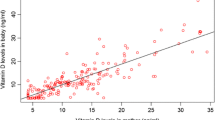Abstract
Purpose
There is paucity of literature pertaining to association between vitamin D deficiency and preeclampsia from sunshine-rich countries like India. Further none of the studies have reported on relation with severity of preeclampsia. This study was carried out with a purpose of studying relation between vitamin D deficiency and preeclampsia and its complications.
Methods
Seventy-four nulliparous preeclamptic women with singleton pregnancy and without any known medical disorder and 100 healthy nulliparous controls of same age were enrolled. Serum vitamin D concentration of the two groups was compared. We also compared the vitamin D level of women with mild and severe preeclampsia and with or without various complications of preeclampsia.
Results
Eighty-four percent of women were vitamin D deficient. Mean serum vitamin D was significantly lower among cases (9.7 ± 4.95 ng/ml) as compared to controls (14.8 ± 6.68 ng/ml); p = 0.0001. Women with mild preeclampsia (9.44 ± 5.63 ng/ml) had similar vitamin D level as those with severe disease (9.8 ± 4.79 ng/ml) (p = 0.811). There was no difference in vitamin D level of women with eclampsia (p = 0.956) or imminent eclampsia (p = 0.310) and those without these complications.
Conclusion
There is high prevalence of vitamin D deficiency among pregnant women in India. Women with preeclampsia had significantly lower vitamin D level as compared to normal women. Severity of the disease was not related to vitamin D level.
Similar content being viewed by others
References
Duckitt K, Harrington D (2005) Risk factors for pre-eclampsia at antenatal booking: systematic review of controlled studies. BMJ 330:565
Guidotti R (1988) Geographic variation in the incidence of hypertension in pregnancy. Am J Obst Gynecol 158:80–83
Roberts CL, Ford JB, Algert CS, Antonsen S, Chalmers J, Cnattinguis S et al (2011) Population-based trends in pregnancy hypertension and pre-eclampsia: an international comparative study. BMJ Open 1:e000101. doi:10.1136/bmjopen-2011-000101
Khan KS, Wojdyla D, Say L, Gülmezoglu AM, Van Look PFA (2006) WHO analysis of causes of maternal death: a systematic review. Lancet 367:1066–1074
Evans KN, Bulmer JN, Kilby MD (2004) Hewison M Vitamin D and placental-decidual function. J Soc Gynecol Investig 11:263–271
Norman AW (2006) Vitamin D receptor: new assignments for an already busy receptor. Endocrinology 147:5542–5548
Zhender D, Bland R, Williams MC, McNinch RW, Howie AJ, Stewart PM et al (2001) Extrarenal expression of 25-hydroxyvitamin d(3)-1 alpha-hydroxylase. J Clin Endocrinol Metab 86:888–894
Holmes VA, Barnes MS, Alexander HD, Mc Faul P, Wallace JM (2009) Vitamin D deficiency and insufficiency in pregnant women: a longitudinal study. Br J Nutr 102:876–881
Bodnar LM, Simhan HN, Powers RW, Frank MP, Cooperstein E, Roberts JM (2007) High prevalence of vitamin D insufficiency in black and white pregnant women residing in the northern US and their neonates. J Nutr 137:447–452
Lee JM, Smith JR, Philipp BL, Chen TC, Mathieu J, Holick MF (2007) Vitamin D deficiency in a healthy group of mothers and newborn infants. Clin Pediatr (Phila) 46:42–44
Bodnar LM, Catov JM, Simhan HN, Holick MF, Powers RW, Roberts JM (2007) Maternal vitamin D deficiency increases the risk of preeclampsia. J Clin Endocrinol Metab 92:3517–3522
Baker AM, Haeri S, Camargo CA, Espinola JA, Stuebe AM (2010) A nested case–control study of midgestation vitamin D deficiency and risk of severe preeclampsia. J Clin Endocrinol Metab 95:5105–5109
Brannon PM (2012) Vitamin D and adverse pregnancy outcomes: beyond bone health and growth. Proc Nutr Soc 71:205–212
Farrant HJ, Krishnaveni GV, Hill JC, Boucher BJ, Fisher DJ, Noonan K et al (2009) Vitamin D insufficiency is common in Indian mothers but is not associated with gestational diabetes or variation in newborn size. Eur J Clin Nutr 63:646–652
Sachan A, Gupta R, Das V, Agarwal A, Awasthi PK, Bhatia V (2005) High prevalence of vitamin D deficiency among pregnant women and their newborns in northern India. Am J Clin Nutr 81:1060–1064
Marya RK, Rathee S, Manrow M (1987) Effect of calcium and vitamin D supplementation on toxaemia of pregnancy. Gynecol Obstet Invest 24:38–42
American College of Obstetricians and Gynecologists (ACOG) Practice bulletin (2002) Diagnosis and management of preeclampsia and eclampsia. Obstet Gynecol 99(1):159–167
Holick MF, Binkley NC, Bischoff-Ferrari HA, Gordon CM, Hanley DA, Heaney RP et al (2011) Evaluation, treatment, and prevention of vitamin D deficiency: an Endocrine Society clinical practice guideline. J Clin Endocrinol Metab 96:1911–1930
Robinson CJ, Alanis MC, Wagner CL, Hollis BW, Johnson DD (2010) Plasma 25-hydroxyvitamin D levels in early -onset severe preeclampsia. Am J Obstet Gynecol 203:1–6
Olsen SF, Secher NJ (1990) A possible preventive effect of low-dose fish oil on early delivery and pre-eclampsia: indications from a 50-year-old controlled trial. Br J Nutr 64:599–609
Merewood A, Mehta SD, Chen TC, Bauchner H, Holick MF (2009) Association between vitamin D deficiency and primary cesarean section. J Clin Endocrinol Metab 94:940–945
Marya RK, Rathee S, Dua V, Sangwan K (1988) Effect of vitamin D supplementation during pregnancy on foetal growth. Indian J Med Res 88:488–492
Karim SA, Nusrat U, Aziz S (2011) Vitamin D deficiency in pregnant women and their newborns as seen at a tertiary-care center in Karachi, Pakistan. Int J Gynecol Obstet 112:59–62
Conflict of interest
We report no financial relation with any organization. We declare that authors have full control of the primary data. The authors declare that they have no conflict of interest.
Author information
Authors and Affiliations
Corresponding author
Rights and permissions
About this article
Cite this article
Singla, R., Gurung, P., Aggarwal, N. et al. Relationship between preeclampsia and vitamin D deficiency: a case control study. Arch Gynecol Obstet 291, 1247–1251 (2015). https://doi.org/10.1007/s00404-014-3550-8
Received:
Accepted:
Published:
Issue Date:
DOI: https://doi.org/10.1007/s00404-014-3550-8



